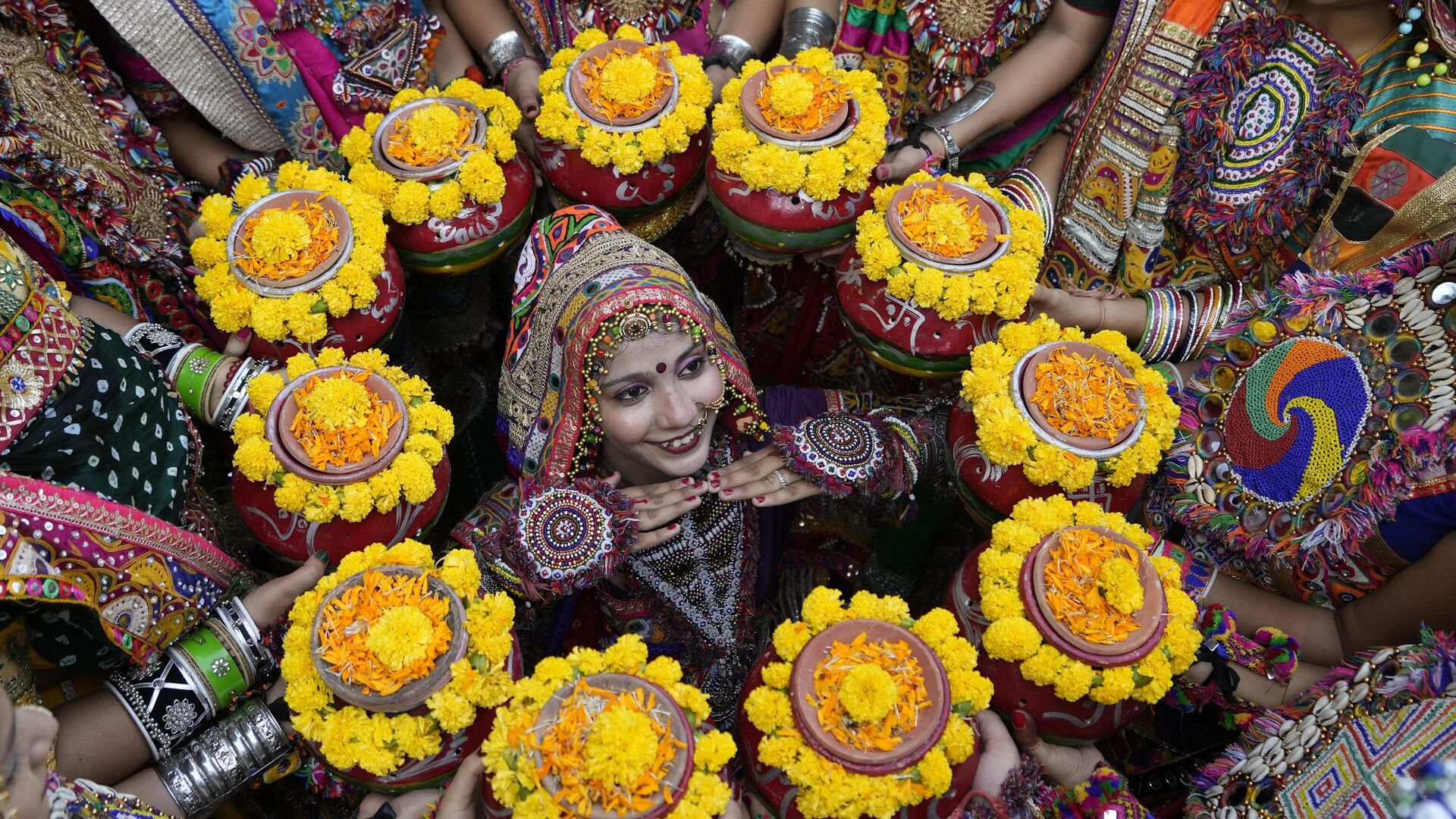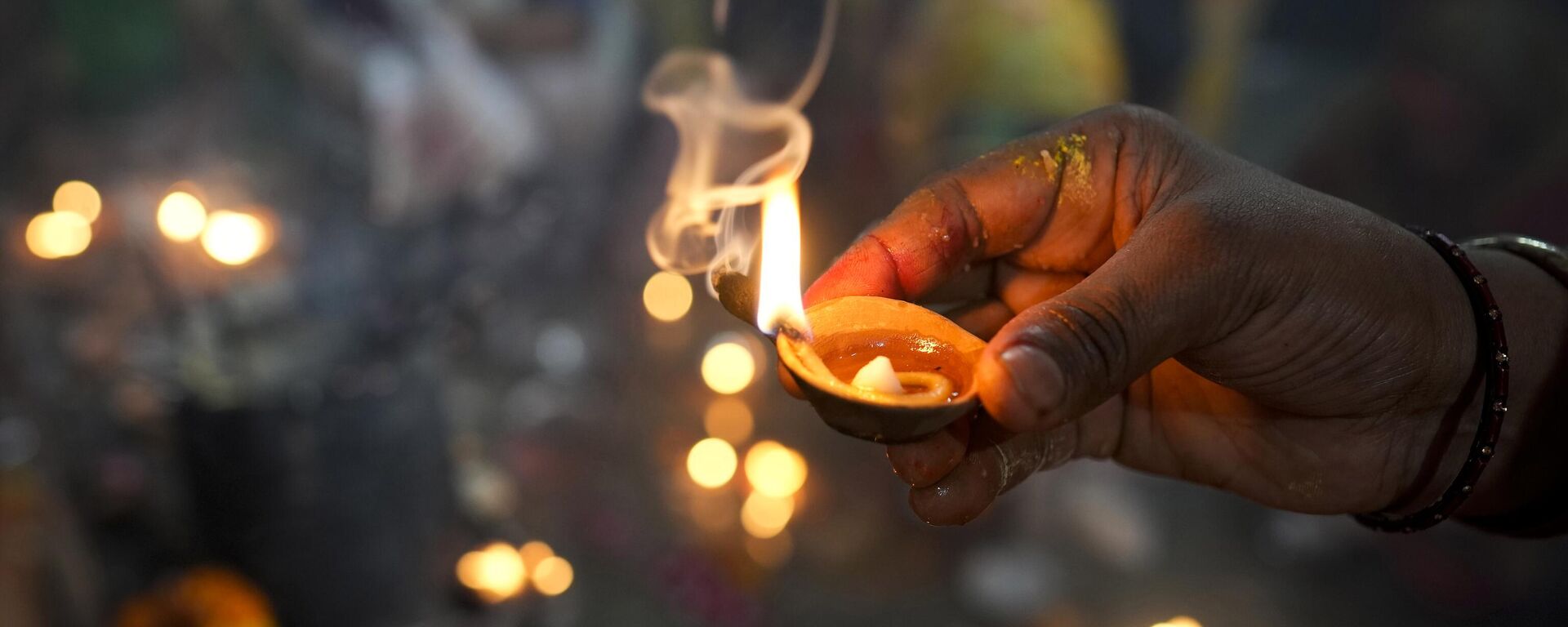https://sputniknews.in/20231015/how-to-fast-for-navratri-4789205.html
How to Fast for Navratri?
How to Fast for Navratri?
Sputnik India
Navratri, a Hindu festival celebrating the nine incarnations of Goddess Durga, will take place from October 15 to October 24. During this time, scores of devotees fast to detoxify their mind, body and soul by eating sattvik foods.
2023-10-15T19:36+0530
2023-10-15T19:36+0530
2023-10-15T19:36+0530
navratri
india
hindu festival
hindu deities
hinduism
hindu goddess kali
hindu devotees
goddess durga
food
vegetarian food
https://cdn1.img.sputniknews.in/img/07e7/0a/0f/4846241_0:0:3072:1728_1920x0_80_0_0_b4966b155a246062418d8cbdeb8391ae.jpg
Navratri, a Hindu festival celebrating the nine incarnations of Goddess Durga, takes place from 15 to 24 October. During this time, devotees fast to detoxify their mind, body and soul by eating sattvic foods.Some people observe fasting, called 'Vrat' in Hindi, only on the first and last days of Navratri.However, many faithfully continue the fast for nine days, eating only sattvic foods, which are simple, natural and unprocessed foods that are light, easily digestible and free from additives, excessive spices or fats.Sattvic foods are thought to possess a soothing influence on the mind, aiding in the preservation of emotional equilibrium and the alleviation of stress or anxiety levels throughout the festive season.To maintain a well-rounded nutritional intake while fasting, it is crucial to include a diverse selection of sattvic fruits, vegetables, nuts, seeds, and dairy products in your diet.Spuntik India brings to you a guide of what to eat andto avoid during Navratri.What Food is Allowed in Navratri Fasting?What Foods to Avoid During Navratri?During Navratri, it is essential to nourish our bodies with simple, wholesome meals that promote a sense of peace and tranquility while enhancing our immune system and metabolism.Whether they are fasting or not, many Hindu devotees choose to adhere to a vegetarian or Satvik diet. They purposefully avoid consuming anything that is heavy or rich, as well as anything categorized as Tamsik or Rajasic food. These food categories can induce feelings of lethargy, dullness, and laziness.Here are some of the foods that people avoid during Navratri.Other vegetables that are considered tamasic include leeks, mushrooms, okra, and brinjal.What Popular Navratri Recipes to Cook During Fasting?Some of the popular Navratri recipes include sabudana aloo moongfali tikki (cutlet), shakarkandi ki chaat, singhare ke pakore, fruit salad, aloo tikki, kuttu pakore, kuttu singhare ke atte ka dhokla, crispy arbi, and others.Some popular main course recipes for Navratri fasting include malai kofta, vrat ke aloo, vrat ki arbi, falhari paneer ki sabzi, rat wale dahi ke aloo, samak rice, singhara atta, kadhi, fried aloo with dahi, sabudana khichdhi, samak rice pulao, samak dosa with allu, singdana and green chutney, makhana dahi wada, kuttu atta poori with aloo, kaddu ki sabji, lauki ka raita, dahi ke aloo, vrat ke aloo, aloo tamatar ki sabji, and fruit raita.Some of the popular Navratri dessert recipes include sabudana kheer, lauki ki kheer, dry fruit kheer, sama chawal kheer, carrot kheer, carrot halwa, carrot burfi, aloo halwa, phirni, coconut almond burfi and kaju katli.
https://sputniknews.in/20230927/navratri-nine-avatars-of-goddess-durga-worshipped-during-festival-4451765.html
india
Sputnik India
feedback.hindi@sputniknews.com
+74956456601
MIA „Rossiya Segodnya“
2023
Sangeeta Yadav
https://cdn1.img.sputniknews.in/img/07e6/0c/0f/110602_0:0:641:640_100x100_80_0_0_c298016a79eb02ef8caa9d1f688c12a5.jpg
Sangeeta Yadav
https://cdn1.img.sputniknews.in/img/07e6/0c/0f/110602_0:0:641:640_100x100_80_0_0_c298016a79eb02ef8caa9d1f688c12a5.jpg
News
en_IN
Sputnik India
feedback.hindi@sputniknews.com
+74956456601
MIA „Rossiya Segodnya“
Sputnik India
feedback.hindi@sputniknews.com
+74956456601
MIA „Rossiya Segodnya“
Sangeeta Yadav
https://cdn1.img.sputniknews.in/img/07e6/0c/0f/110602_0:0:641:640_100x100_80_0_0_c298016a79eb02ef8caa9d1f688c12a5.jpg
navratri, hindu festival, nine incarnations of goddess durga, tamsik food, rajasic food, devotees fast, detoxify mind, body, soul, eat sattvic foods, navratri 2023, navratri, navratri 2023 march, navratri colours, happy navratri, chaitra navratri 2023, navratri 2023 date, navratri march 2023, navratri kab hai, navratri image, navratri colour, navratri wishes, navratri 2023 march date, navratri kab se hai, happy navratri wishes, navratri wishes in hindi, goddess durga, incarnations, vijaydashmi, dussehra festival, lord rama, ravana, why is 'navratri' celebrated?power of womanhood, chaitra navratri, sharada navratre, devotees worship, goddess shailaputri, goddess brahmacharini, goddess chandraghanta, goddess kushmanda, goddess skandamata, goddess katyayani, goddess kaalaratri, goddess mahagauri, goddess siddhidatri, shubh mahurat, how is navratri celebrated?temples, durga puja pandals, worshipping idols of goddess durga, navratri colors, dhunuchi dance, folk dance garba, dandiya, fast during navratri, fasting during navratri, navratra special vegetarian, navratri recipes, fasting during navratri, fasts, vrat, unprocessed foods, easy to digest, what to eat and what not to eat during navratri, rock salt, sendha namak,
navratri, hindu festival, nine incarnations of goddess durga, tamsik food, rajasic food, devotees fast, detoxify mind, body, soul, eat sattvic foods, navratri 2023, navratri, navratri 2023 march, navratri colours, happy navratri, chaitra navratri 2023, navratri 2023 date, navratri march 2023, navratri kab hai, navratri image, navratri colour, navratri wishes, navratri 2023 march date, navratri kab se hai, happy navratri wishes, navratri wishes in hindi, goddess durga, incarnations, vijaydashmi, dussehra festival, lord rama, ravana, why is 'navratri' celebrated?power of womanhood, chaitra navratri, sharada navratre, devotees worship, goddess shailaputri, goddess brahmacharini, goddess chandraghanta, goddess kushmanda, goddess skandamata, goddess katyayani, goddess kaalaratri, goddess mahagauri, goddess siddhidatri, shubh mahurat, how is navratri celebrated?temples, durga puja pandals, worshipping idols of goddess durga, navratri colors, dhunuchi dance, folk dance garba, dandiya, fast during navratri, fasting during navratri, navratra special vegetarian, navratri recipes, fasting during navratri, fasts, vrat, unprocessed foods, easy to digest, what to eat and what not to eat during navratri, rock salt, sendha namak,
Navratri, a Hindu festival celebrating the nine incarnations of Goddess Durga, takes place from 15 to 24 October. During this time, devotees fast to detoxify their mind, body and soul by eating sattvic foods.
Some people observe fasting, called 'Vrat' in Hindi, only on the first and last days of Navratri.
However, many faithfully continue the
fast for nine days, eating only sattvic foods, which are simple,
natural and unprocessed foods that are light, easily digestible and free from additives, excessive spices or fats.
Sattvic foods are thought to possess a soothing influence on the mind, aiding in the preservation of emotional equilibrium and the alleviation of stress or anxiety levels throughout the festive season.
To maintain a well-rounded n
utritional intake while fasting, it is crucial to include a diverse selection of sattvic fruits, vegetables, nuts, seeds, and dairy products in your diet.
Spuntik India brings to you a guide of what to eat andto avoid during Navratri.
What Food is Allowed in Navratri Fasting?
Rock salt (sendha namak): Rock salt is considered to be unadulterated, pure and therefore falls under the category of sattvic food. All foods are cooked with rock salt only during Navratri.
Whole spices: Cumin seeds (jeera), black peppercorns (kali mirch), cinnamon, cardamom (elaichi), cloves (laung) and carom seeds (ajwain) can be consumed.
Fasting Flours: Flours made from millets (baajara) such as barnyard millet (samak rice), finger millet (ragi), amaranth flour (rajgira ke atta) and even water chestnut (singhare), buckwheat (kuttu atta), fox nut flour (makhane ka aata) and sago (sabudana) are considered sattvic foods and can be consumed during the Navratri fast.
Dairy Products: Dairy products are an important source of protein and are considered sattvic. Therefore, consumption of milk, cottage cheese (paneer), ghee, curd, buttermilk, malai and khoya is permitted during Navratri.
Fruits: All types of fruits and coconut water can be consumed during Navratri fasting. Prepare smoothies and have them solid for breakfast or as a snack.
Nuts: Peanuts (moongphali), makhana (fox nuts), cashew nuts, almonds, pistachios, walnuts, pine nuts, sunflower seeds, pumpkin seeds, watermelon seeds can be consumed during Navratri fast.
Vegetables: Potatoes (aloo), colocasia (arbi), sweet potato (shakarkhand), raw banana, yellow pumpkin (kaddu), raw green papaya, cucumber, carrot, ginger (adrak), green chilli, lemon (neeboo), coriander leaves (hara dhaniya), tomato, bottle gourd (lauki) can be consumed. Sattvic vegetables are high in fibre and minerals and give you lots of energy and keep you hydrated.
Cooking Oil: Ghee or peanut oil (avoid refined oils).
What Foods to Avoid During Navratri?
During
Navratri, it is essential to nourish our bodies with simple, wholesome meals that promote a sense of peace and tranquility while enhancing our immune system and metabolism.
Whether they are fasting or not, many Hindu devotees choose to adhere to a vegetarian or Satvik diet. They purposefully avoid consuming anything that is heavy or rich, as well as anything categorized as Tamsik or Rajasic food. These food categories can induce feelings of lethargy, dullness, and laziness.
Here are some of the foods that people avoid during Navratri.
Non-vegetarian foods: This includes meat and poultry products including eggs, chicken, fish, lamb, seafood and others.
Onion & garlic, other vegetables: Onions and garlic are considered tamasic and rajasic foods and should be avoided in any form.
Other vegetables that are considered tamasic include leeks, mushrooms, okra, and brinjal.
Table salt: During Navratri, people tend to avoid consuming table salt due to its artificial processing, which increases the risk of adulteration. All processed foods include table salt, hence it is a strict no-no during Navratri.
Alcohol: All alcohol and alcoholic cocktails are considered tamasic and are avoided during the nine days of Navratri. Some people also avoid caffeinated drinks like coffee and tea and aerated drinks.
Cereals And Legumes: Cereals such as rice, wheat, oats and their flours, chickpea flour, maize flour and whole wheat flour are considered rajasic foods and are avoided during Navratri 2023. All types of pulses and legumes, lentils, semolina (rava) are also avoided.
Spices: Rich powdered spices like turmeric, red chillies, garam masala, asafoetida (hing), nutmeg, and others are avoided during Navratri.
What Popular Navratri Recipes to Cook During Fasting?
Some of the popular Navratri recipes include sabudana aloo moongfali tikki (cutlet), shakarkandi ki chaat, singhare ke pakore, fruit salad, aloo tikki, kuttu pakore, kuttu singhare ke atte ka dhokla, crispy arbi, and others.
Some popular main course recipes for Navratri fasting include malai kofta, vrat ke aloo, vrat ki arbi, falhari paneer ki sabzi, rat wale dahi ke aloo, samak rice, singhara atta, kadhi, fried aloo with dahi, sabudana khichdhi, samak rice pulao, samak dosa with allu, singdana and green chutney, makhana dahi wada, kuttu atta poori with aloo, kaddu ki sabji, lauki ka raita, dahi ke aloo, vrat ke aloo, aloo tamatar ki sabji, and fruit raita.
Some of the popular Navratri dessert recipes include sabudana kheer, lauki ki kheer, dry fruit kheer, sama chawal kheer, carrot kheer, carrot halwa, carrot burfi, aloo halwa, phirni, coconut almond burfi and kaju katli.




